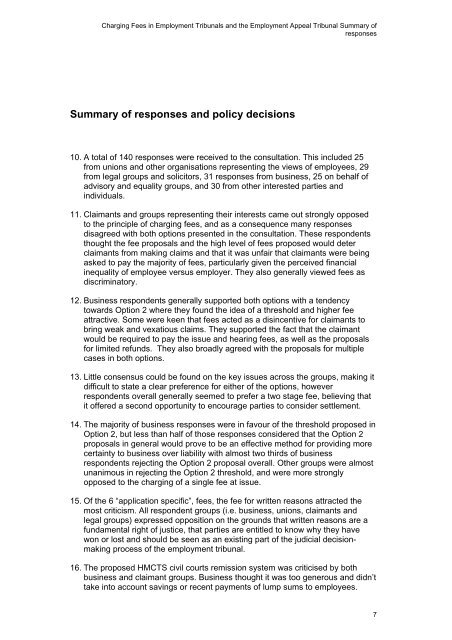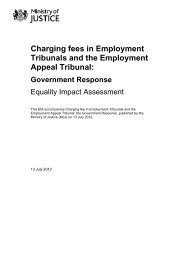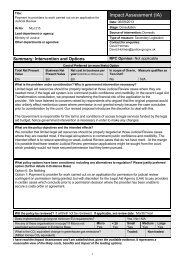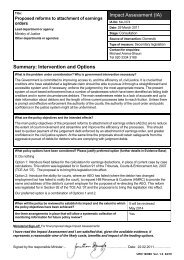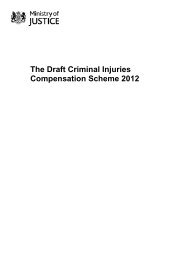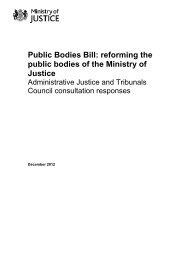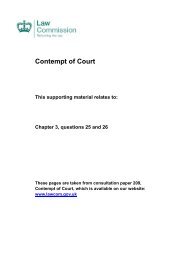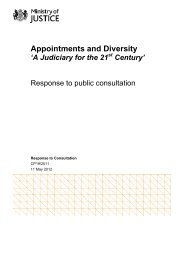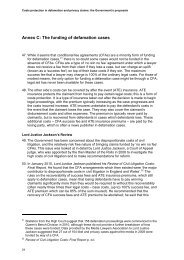Charging Fees in Employment Tribunals and the ... - Ministry of Justice
Charging Fees in Employment Tribunals and the ... - Ministry of Justice
Charging Fees in Employment Tribunals and the ... - Ministry of Justice
Create successful ePaper yourself
Turn your PDF publications into a flip-book with our unique Google optimized e-Paper software.
<strong>Charg<strong>in</strong>g</strong> <strong>Fees</strong> <strong>in</strong> <strong>Employment</strong> <strong>Tribunals</strong> <strong>and</strong> <strong>the</strong> <strong>Employment</strong> Appeal Tribunal Summary <strong>of</strong>responsesSummary <strong>of</strong> responses <strong>and</strong> policy decisions10. A total <strong>of</strong> 140 responses were received to <strong>the</strong> consultation. This <strong>in</strong>cluded 25from unions <strong>and</strong> o<strong>the</strong>r organisations represent<strong>in</strong>g <strong>the</strong> views <strong>of</strong> employees, 29from legal groups <strong>and</strong> solicitors, 31 responses from bus<strong>in</strong>ess, 25 on behalf <strong>of</strong>advisory <strong>and</strong> equality groups, <strong>and</strong> 30 from o<strong>the</strong>r <strong>in</strong>terested parties <strong>and</strong><strong>in</strong>dividuals.11. Claimants <strong>and</strong> groups represent<strong>in</strong>g <strong>the</strong>ir <strong>in</strong>terests came out strongly opposedto <strong>the</strong> pr<strong>in</strong>ciple <strong>of</strong> charg<strong>in</strong>g fees, <strong>and</strong> as a consequence many responsesdisagreed with both options presented <strong>in</strong> <strong>the</strong> consultation. These respondentsthought <strong>the</strong> fee proposals <strong>and</strong> <strong>the</strong> high level <strong>of</strong> fees proposed would deterclaimants from mak<strong>in</strong>g claims <strong>and</strong> that it was unfair that claimants were be<strong>in</strong>gasked to pay <strong>the</strong> majority <strong>of</strong> fees, particularly given <strong>the</strong> perceived f<strong>in</strong>ancial<strong>in</strong>equality <strong>of</strong> employee versus employer. They also generally viewed fees asdiscrim<strong>in</strong>atory.12. Bus<strong>in</strong>ess respondents generally supported both options with a tendencytowards Option 2 where <strong>the</strong>y found <strong>the</strong> idea <strong>of</strong> a threshold <strong>and</strong> higher feeattractive. Some were keen that fees acted as a dis<strong>in</strong>centive for claimants tobr<strong>in</strong>g weak <strong>and</strong> vexatious claims. They supported <strong>the</strong> fact that <strong>the</strong> claimantwould be required to pay <strong>the</strong> issue <strong>and</strong> hear<strong>in</strong>g fees, as well as <strong>the</strong> proposalsfor limited refunds. They also broadly agreed with <strong>the</strong> proposals for multiplecases <strong>in</strong> both options.13. Little consensus could be found on <strong>the</strong> key issues across <strong>the</strong> groups, mak<strong>in</strong>g itdifficult to state a clear preference for ei<strong>the</strong>r <strong>of</strong> <strong>the</strong> options, howeverrespondents overall generally seemed to prefer a two stage fee, believ<strong>in</strong>g thatit <strong>of</strong>fered a second opportunity to encourage parties to consider settlement.14. The majority <strong>of</strong> bus<strong>in</strong>ess responses were <strong>in</strong> favour <strong>of</strong> <strong>the</strong> threshold proposed <strong>in</strong>Option 2, but less than half <strong>of</strong> those responses considered that <strong>the</strong> Option 2proposals <strong>in</strong> general would prove to be an effective method for provid<strong>in</strong>g morecerta<strong>in</strong>ty to bus<strong>in</strong>ess over liability with almost two thirds <strong>of</strong> bus<strong>in</strong>essrespondents reject<strong>in</strong>g <strong>the</strong> Option 2 proposal overall. O<strong>the</strong>r groups were almostunanimous <strong>in</strong> reject<strong>in</strong>g <strong>the</strong> Option 2 threshold, <strong>and</strong> were more stronglyopposed to <strong>the</strong> charg<strong>in</strong>g <strong>of</strong> a s<strong>in</strong>gle fee at issue.15. Of <strong>the</strong> 6 “application specific”, fees, <strong>the</strong> fee for written reasons attracted <strong>the</strong>most criticism. All respondent groups (i.e. bus<strong>in</strong>ess, unions, claimants <strong>and</strong>legal groups) expressed opposition on <strong>the</strong> grounds that written reasons are afundamental right <strong>of</strong> justice, that parties are entitled to know why <strong>the</strong>y havewon or lost <strong>and</strong> should be seen as an exist<strong>in</strong>g part <strong>of</strong> <strong>the</strong> judicial decisionmak<strong>in</strong>gprocess <strong>of</strong> <strong>the</strong> employment tribunal.16. The proposed HMCTS civil courts remission system was criticised by bothbus<strong>in</strong>ess <strong>and</strong> claimant groups. Bus<strong>in</strong>ess thought it was too generous <strong>and</strong> didn’ttake <strong>in</strong>to account sav<strong>in</strong>gs or recent payments <strong>of</strong> lump sums to employees.7


